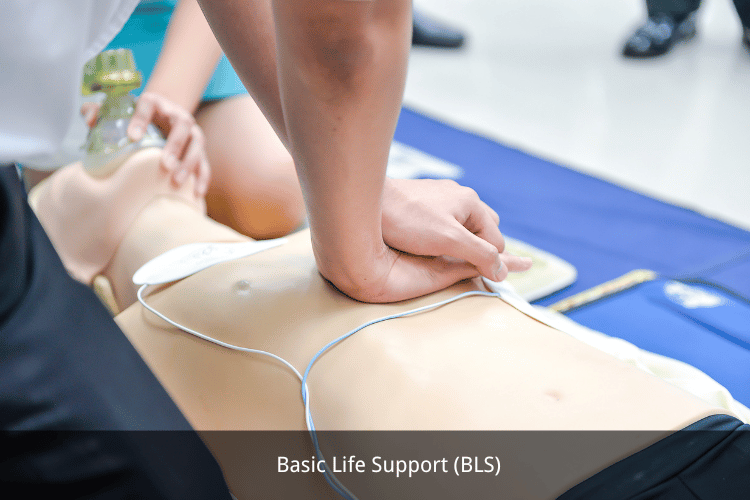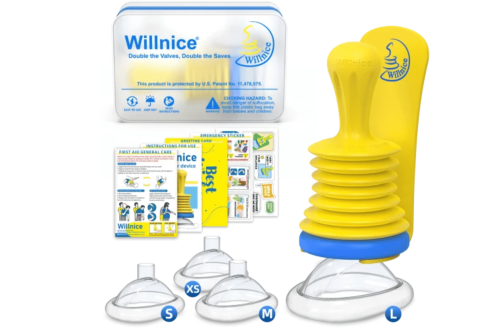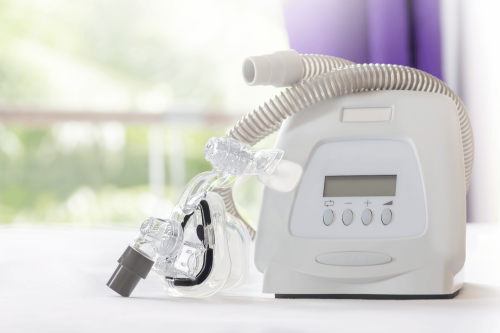
Basic Life Support (BLS) certification is a cornerstone of emergency medical training, equipping healthcare professionals with essential skills like CPR and AED use. But how many Continuing Education (CE) hours is BLS worth? This article examines the CE credit value of BLS certification, its significance in professional development, and how it contributes to maintaining licensure and improvingpatient care.
Understanding BLS and CE Credits
What is Basic Life Support (BLS)?
 Basic Life Support (BLS) refers to a set of essential medical procedures and techniques used to provide immediate care to individuals experiencing life-threatening emergencies, such as cardiac arrest, respiratory distress, or airway obstruction. BLS is designed to maintain adequate circulation and ventilation until advanced medical care can be administered. It is a foundational skill for healthcare providers, first responders, and even laypersons trained in emergency care.
BLS training typically includes techniques such as high-quality cardiopulmonary resuscitation (CPR), the use of automated external defibrillators (AEDs), and methods for relieving airway obstructions in both adults and children. The emphasis is on rapid assessment, effective chest compressions, and timely defibrillation to improve survival rates in critical situations. BLS certification is often a mandatory requirement for healthcare professionals, as it equips them with the skills needed to respond effectively in emergencies, both in clinical settings and the community.
Basic Life Support (BLS) refers to a set of essential medical procedures and techniques used to provide immediate care to individuals experiencing life-threatening emergencies, such as cardiac arrest, respiratory distress, or airway obstruction. BLS is designed to maintain adequate circulation and ventilation until advanced medical care can be administered. It is a foundational skill for healthcare providers, first responders, and even laypersons trained in emergency care.
BLS training typically includes techniques such as high-quality cardiopulmonary resuscitation (CPR), the use of automated external defibrillators (AEDs), and methods for relieving airway obstructions in both adults and children. The emphasis is on rapid assessment, effective chest compressions, and timely defibrillation to improve survival rates in critical situations. BLS certification is often a mandatory requirement for healthcare professionals, as it equips them with the skills needed to respond effectively in emergencies, both in clinical settings and the community.
Definition of Continuing Education (CE)
Continuing Education (CE) refers to structured learning activities designed to help professionals maintain and enhance their knowledge, skills, and competencies in their respective fields. In the context of healthcare, CE programs are essential for ensuring that practitioners stay updated with the latest advancements, guidelines, and best practices in patient care. These programs can take various forms, including workshops, online courses, seminars, and hands-on training sessions. CE credits are awarded upon the successful completion of these activities, serving as a measure of the time and effort invested in professional development. For healthcare providers, CE is not just a means of staying informed—it is often a regulatory requirement for maintaining licensure or certification. By participating in CE programs, professionals can ensure they deliver high-quality care that aligns with current standards and evidence-based practices.
Continuing Education (CE)
Importance of CE Hours in Healthcare
Continuing Education (CE) hours play a critical role in the healthcare industry, as they directly impact the quality of care provided to patients. CE hours are a quantifiable measure of the time healthcare professionals dedicate to expanding their expertise and staying current with medical advancements. These hours are often mandated by licensing boards, professional organizations, and employers to ensure that practitioners remain competent and capable of meeting the evolving demands of their roles.- Enhancing Patient Care: CE programs equip healthcare providers with the latest knowledge and skills, enabling them to adopt new technologies, treatments, and protocols. This ensures that patients receive care that is both effective and aligned with the most recent medical standards.
- Maintaining Licensure and Certification: Many healthcare professions require a specific number of CE hours for license renewal or certification maintenance. This ensures that practitioners remain actively engaged in their professional development and adhere to regulatory requirements.
- Adapting to Industry Changes: The healthcare field is constantly evolving, with new research, treatments, and technologies emerging regularly. CE hours help professionals stay informed about these changes, allowing them to adapt their practices and improve outcomes.
- Fostering Professional Growth: Beyond meeting regulatory requirements, CE hours provide opportunities for personal and professional growth. They allow practitioners to explore new areas of interest, specialize in specific fields, and advance their careers.
- Promoting Interdisciplinary Collaboration: Many CE programs encourage collaboration among healthcare professionals from different disciplines. This fosters a team-based approach to patient care, improving communication and coordination across various specialties.
BLS Certification and CE Hours
How Many CE Hours is BLS Worth?
The number of Continuing Education (CE) hours awarded for Basic Life Support (BLS) certification can vary depending on the course provider and the accrediting organization. On average, a standard BLS certification course is worth approximately 2 to 4 CE hours. This includes the time spent on both theoretical instruction and hands-on practice, such as performing high-quality CPR, using an automated external defibrillator (AED), and managing airway obstructions. Renewal courses for BLS certification, which are typically shorter than initial certification programs, may offer fewer CE hours, often ranging from 1.5 to 2 hours. It’s important to note that the exact number of CE hours is determined by the course’s curriculum, duration, and alignment with accrediting body standards. Healthcare professionals should verify the CE credit value with their course provider to ensure it meets the requirements of their licensing board or employer.Accreditation for BLS Courses
Accreditation is a critical factor in determining the validity and recognition of CE hours earned through BLS certification. Accredited BLS courses are designed to meet the standards set by professional organizations and regulatory bodies, ensuring that the training is comprehensive, evidence-based, and aligned with current guidelines. Common accrediting organizations for BLS courses include the American Heart Association (AHA), the American Red Cross, and other nationally recognized institutions. When selecting a BLS course, healthcare professionals should confirm that the program is accredited and approved by their licensing board or employer. Accredited courses not only provide CE hours but also ensure that participants receive high-quality training that adheres to the latest resuscitation science and best practices. Additionally, accredited programs often issue certificates of completion that clearly indicate the number of CE hours earned, simplifying the documentation process for license renewal or certification maintenance.Comparing CE Hours Across Different Programs
The number of CE hours awarded for various healthcare training programs can differ significantly based on the course content, complexity, and duration. While BLS certification typically offers 2 to 4 CE hours, other programs may provide more extensive training and, consequently, higher CE credit values. Below is a comparison of CE hours across common healthcare training programs:- Advanced Cardiovascular Life Support (ACLS): ACLS courses, which build on the foundational skills taught in BLS, often provide 8 to 12 CE hours for initial certification and 4 to 6 hours for renewal courses. These programs cover advanced resuscitation techniques, including rhythm interpretation, medication administration, and team dynamics.
- Pediatric Advanced Life Support (PALS): PALS certification focuses on managing pediatric emergencies and typically awards 8 to 12 CE hours for initial training and 4 to 6 hours for renewals. The course includes topics such as pediatric assessment, airway management, and shock treatment.
- Trauma Nursing Core Course (TNCC): TNCC is a specialized program for nurses managing trauma patients and often provides 16 to 20 CE hours. This comprehensive course includes both didactic instruction and hands-on simulations.
- Basic Life Support (BLS): As mentioned earlier, BLS certification offers fewer CE hours (2 to 4) compared to advanced courses, as it focuses on fundamental skills like CPR and AED use. However, it remains a vital component of healthcare training.
- Specialized Workshops or Seminars: Shorter workshops or topic-specific seminars may offer 1 to 3 CE hours, depending on the subject matter and duration. These programs are often used to supplement broader training initiatives.
Continuing Medical Education (CME) and BLS
Understanding CME Credits
Continuing Medical Education (CME) credits are a formal measure of the time healthcare professionals spend participating in educational activities designed to enhance their knowledge, skills, and performance in medical practice. These credits are essential for maintaining licensure, certification, and professional competency. CME activities can include conferences, workshops, online courses, and hands-on training sessions, all of which are tailored to meet the evolving needs of healthcare providers. CME credits are typically awarded based on the duration and complexity of the educational activity. For example, one CME credit is often equivalent to one hour of participation in a qualifying program. Accredited CME activities are governed by organizations such as the Accreditation Council for Continuing Medical Education (ACCME) in the United States, ensuring that the content is evidence-based, relevant, and aligned with current medical standards. Healthcare professionals are encouraged to select CME programs that address their specific areas of practice, enabling them to stay updated on advancements and improve patient care.How BLS Relates to ACLS and PALS
Basic Life Support (BLS) serves as the foundation for more advanced resuscitation training programs, such as Advanced Cardiovascular Life Support (ACLS) and Pediatric Advanced Life Support (PALS). While BLS focuses on fundamental skills like high-quality CPR, the use of automated external defibrillators (AEDs), and basic airway management, ACLS and PALS build upon these principles to address more complex medical emergencies.- Advanced Cardiovascular Life Support (ACLS): ACLS training expands on BLS by incorporating advanced techniques for managing cardiac arrest, stroke, and other life-threatening conditions. It includes rhythm interpretation, medication administration, and team-based resuscitation strategies. BLS certification is often a prerequisite for enrolling in ACLS courses, as it ensures participants have a solid understanding of basic resuscitation skills.
- Pediatric Advanced Life Support (PALS): PALS focuses on the unique needs of pediatric patients, covering topics such as pediatric assessment, airway management, and shock treatment. Like ACLS, PALS requires a foundational knowledge of BLS, as many of the skills taught in BLS are directly applicable to pediatric emergencies.
Requesting CE Credits for BLS Training
Healthcare professionals who complete Basic Life Support (BLS) training may be eligible to receive Continuing Education (CE) credits, which can be applied toward licensure renewal or certification maintenance. To request CE credits for BLS training, follow these steps:- Verify Accreditation: Ensure that the BLS course you completed is accredited by a recognized organization, such as the American Heart Association (AHA) or the American Red Cross. Accredited courses are more likely to be accepted by licensing boards and professional organizations.
- Obtain Documentation: After completing the course, request a certificate of completion from the training provider. This document should include details such as the course title, date of completion, and the number of CE credits awarded.
- Submit to Licensing Board: Submit the certificate of completion to your licensing board or employer as part of your CE documentation. Be sure to follow any specific submission guidelines, such as providing additional forms or completing an online application.
- Track Your CE Credits: Maintain a record of all CE activities, including BLS training, to ensure you meet the requirements for licensure renewal. Many professionals use online tracking systems or apps to organize their CE credits and avoid last-minute scrambling during renewal periods.
- Check State or Employer Requirements: Some states or employers may have specific requirements for CE credits, such as a minimum number of hours in certain topics. Verify that your BLS training aligns with these requirements to ensure it counts toward your total CE hours.
Online Courses and CE Options
Benefits of Online BLS Certification Courses
Online Basic Life Support (BLS) certification courses have become a popular option for healthcare professionals and individuals seeking flexible and convenient training. These courses offer a range of benefits, making them an attractive alternative to traditional in-person classes. One of the primary advantages is accessibility. Online courses allow participants to complete the theoretical components of BLS training at their own pace, from any location, eliminating the need to travel to a training center. This is particularly beneficial for busy professionals who need to balance work, family, and continuing education. Another key benefit is the integration of interactive learning tools, such as video demonstrations, quizzes, and simulations, which enhance understanding and retention of critical concepts. Many online programs also provide immediate feedback, allowing learners to identify areas for improvement before progressing. Additionally, online BLS courses are often more cost-effective than in-person training, as they reduce expenses related to travel, materials, and instructor fees. However, it’s important to note that most online BLS certifications require participants to complete an in-person skills assessment to ensure proficiency in hands-on techniques like CPR and AED use.CE Hours for Dental Professionals
Dental professionals, including dentists, dental hygienists, and dental assistants, are often required to complete Continuing Education (CE) hours to maintain their licensure and stay updated on best practices in patient care. Basic Life Support (BLS) certification is a critical component of these requirements, as it equips dental professionals with the skills needed to respond to medical emergencies that may occur in a dental office, such as cardiac arrest or airway obstruction. BLS training for dental professionals typically provides 2 to 4 CE hours, depending on the course provider and curriculum. These hours count toward the total CE requirements mandated by state dental boards or professional organizations. In addition to fulfilling licensure requirements, BLS certification enhances the safety and preparedness of dental teams, ensuring they can provide immediate care in emergencies. Dental professionals should verify that their BLS course is accredited and recognized by their state board to ensure the CE hours are accepted.Continuing Nursing Education (CNE) and BLS
Continuing Nursing Education (CNE) is an essential aspect of professional development for nurses, enabling them to maintain licensure, improve clinical skills, and stay informed about advancements in healthcare. Basic Life Support (BLS) certification is a foundational component of CNE, as it provides nurses with the knowledge and skills needed to manage life-threatening situations, such as cardiac arrest or respiratory failure. BLS courses for nurses typically award 2 to 4 CE hours, which can be applied toward the total CNE requirements set by state nursing boards or certifying organizations. These courses cover critical topics such as high-quality CPR, the use of automated external defibrillators (AEDs), and airway management techniques. For nurses working in acute care settings, BLS certification is often a prerequisite for more advanced training programs, such as Advanced Cardiovascular Life Support (ACLS) or Pediatric Advanced Life Support (PALS). To maximize the benefits of BLS training, nurses should choose accredited courses that align with the standards of their licensing board or employer. Many online BLS programs offer the flexibility to complete the theoretical portion of the training at home, followed by an in-person skills assessment to ensure competency. By integrating BLS certification into their CNE plans, nurses can enhance their ability to provide high-quality care and respond effectively in emergencies.Resources for BLS CE Credits
American Red Cross and BLS Certification
The American Red Cross is a trusted and widely recognized organization offering Basic Life Support (BLS) certification courses that are accredited and designed to meet the needs of healthcare professionals. These courses provide high-quality training in essential life-saving techniques, such as CPR, the use of automated external defibrillators (AEDs), and airway management. The American Red Cross BLS programs are tailored to align with the latest guidelines and evidence-based practices, ensuring participants receive up-to-date and effective training. One of the key benefits of choosing the American Red Cross for BLS certification is the availability of CE credits. Upon successful completion of the course, participants are awarded CE hours that can be applied toward licensure renewal or certification maintenance. The organization also offers flexible learning options, including blended learning formats that combine online coursework with in-person skills assessments. This approach allows healthcare providers to complete the theoretical portion of the training at their own pace while ensuring hands-on proficiency through practical evaluations.Finding Accredited BLS Training Providers
Selecting an accredited training provider is crucial for ensuring that your BLS certification is recognized by licensing boards, employers, and professional organizations. Accredited providers adhere to established standards for curriculum design, instructional quality, and assessment methods, guaranteeing that participants receive comprehensive and reliable training. Here are some tips for finding accredited BLS training providers:- Check Accreditation: Look for courses accredited by reputable organizations such as the American Heart Association (AHA), the American Red Cross, or other nationally recognized institutions. Accreditation ensures that the training meets industry standards and is widely accepted.
- Verify CE Credit Eligibility: Confirm that the course offers CE credits and that these credits are recognized by your licensing board or employer. Most accredited providers clearly state the number of CE hours awarded upon course completion.
- Explore Online and In-Person Options: Many providers offer flexible learning formats, including fully online courses, blended learning, and traditional classroom settings. Choose a format that fits your schedule and learning preferences while ensuring it includes a hands-on skills assessment.
- Read Reviews and Testimonials: Research the provider’s reputation by reading reviews and testimonials from past participants. This can give you insight into the quality of instruction, course materials, and overall experience.
- Compare Costs and Features: While cost is an important factor, prioritize quality and accreditation over price. Some providers may offer additional resources, such as study guides or practice tests, which can enhance your learning experience.
Tracking Your CE Hours Effectively
Keeping track of your Continuing Education (CE) hours is essential for meeting licensure renewal requirements and staying organized. Proper tracking ensures that you can easily document your completed training and avoid last-minute stress during renewal periods. Here are some strategies for effectively managing your CE hours:- Use Digital Tools: Many professionals use online platforms or mobile apps specifically designed for tracking CE hours. These tools allow you to log completed courses, upload certificates, and monitor your progress toward meeting licensure requirements.
- Maintain a Physical Record: In addition to digital tracking, keep a physical folder or binder with copies of your certificates of completion, course descriptions, and other relevant documentation. This serves as a backup in case of technical issues.
- Organize by Renewal Period: Group your CE activities by licensure renewal cycles to ensure you meet the required number of hours within the designated timeframe. This approach makes it easier to identify any gaps in your training.
- Set Reminders: Use calendar reminders or alerts to stay on top of upcoming deadlines for license renewal or certification maintenance. This helps you plan your CE activities in advance and avoid last-minute rushes.
- Verify Requirements Regularly: Licensing boards and professional organizations may update their CE requirements periodically. Stay informed about any changes to ensure your completed hours remain valid and applicable.
Frequently Asked Questions
Q: What are CE hours for BLS certification?
A: Basic Life Support (BLS) certification typically provides 2 to 4 continuing education (CE) hours, though the exact number may vary depending on the course provider and curriculum. These CE hours are designed to enhance healthcare professionals' skills in CPR, AED use, and emergency response, contributing to their professional growth and preparedness.
Q: How does BLS certification contribute to continuing education credits?
A: BLS certification is widely recognized by accrediting organizations, allowing healthcare professionals to earn CE credits that count toward licensure renewal or professional development requirements. By completing BLS training, participants improve their emergency response capabilities, which directly enhances patient care and outcomes.
Q: Who designates CE hours for BLS courses?
A: CE hours for BLS courses are designated by accredited continuing education providers, such as the American Heart Association (AHA) and the Accreditation Council for Continuing Medical Education (ACCME). These organizations ensure that the courses meet rigorous standards for educational quality and relevance to healthcare practice.
Q: Can I receive contact hours for BLS training?
A: Yes, many BLS training programs offer contact hours as part of the CE credits. These contact hours are essential for healthcare professionals who need to meet continuing education requirements. The number of contact hours awarded depends on the course length and the participant’s level of engagement.
Q: How can I claim CE credits for BLS training?
A: To claim CE credits for BLS training, participants must complete the course and pass any required assessments. Upon successful completion, the course provider will issue a certificate that specifies the number of CE hours earned. This certificate can then be submitted to the relevant licensing board or accrediting organization.
Q: Are there online courses available for BLS certification?
A: Yes, many online courses are available for BLS certification. These programs provide comprehensive training in CPR, AED use, and emergency response techniques. They often include interactive modules and flexible scheduling, allowing participants to complete the theoretical portion online, followed by an in-person skills assessment.
Q: How does the Accreditation Council for Pharmacy Education (ACPE) relate to BLS courses?
A: While the ACPE primarily accredits continuing education for pharmacy professionals, some CE providers accredited by the ACPE may offer BLS courses that allow pharmacists and pharmacy technicians to earn CE credits. These credits contribute to their professional development and help meet licensure requirements.
Q: What should I do if I have concerns or complaints about a CE provider?
A: If you have concerns or complaints about a CE provider, start by contacting the provider directly to address the issue. If the problem is not resolved, you can escalate the matter to the appropriate accrediting body, such as the American Nurses Credentialing Center (ANCC) or the Accreditation Council for Continuing Medical Education (ACCME), to file a formal complaint.
Q: How many CEUs are awarded for BLS certification?
A: BLS certification typically awards 0.2 to 0.4 Continuing Education Units (CEUs), which is equivalent to 2 to 4 CE hours. The exact number depends on the course provider and the specific content covered. These CEUs can be applied toward continuing education requirements for healthcare professionals, including nurses, physicians, and dental practitioners.
Conclusion
BLS certification not only provides life-saving skills but also contributes 2 to 4 CE hours, supporting healthcare professionals in meeting licensure requirements and staying current in their field. By choosing accredited courses and tracking CE credits effectively, professionals can ensure compliance while enhancing their ability to respond to emergencies with confidence and competence.








 Login with Google
Login with Google Login with Facebook
Login with Facebook